BE130 Financial Reporting: Dynamics Co. Ltd Issues & Solutions
VerifiedAdded on 2023/06/13
|9
|2126
|189
Report
AI Summary
This assignment provides a detailed analysis of Dynamics Co. Ltd's financial reporting practices, covering key issues such as impairment loss calculation, lease accounting treatment, and intangible asset valuation. The first question focuses on determining the impairment loss on a non-current asset, considering cash flows and government compensation. The second question discusses the accounting treatment for a property leased out by Dynamics Limited, evaluating the application of IAS 16 and IAS 40 using both fair value and cost models. The third question addresses the valuation of a trademark, an intangible asset, and suggests using the cost model with amortization instead of the revaluation model. The assignment utilizes calculations and timelines to illustrate the accounting procedures and provides recommendations for improved financial reporting practices. Desklib offers this and other solved assignments to aid students in their studies.
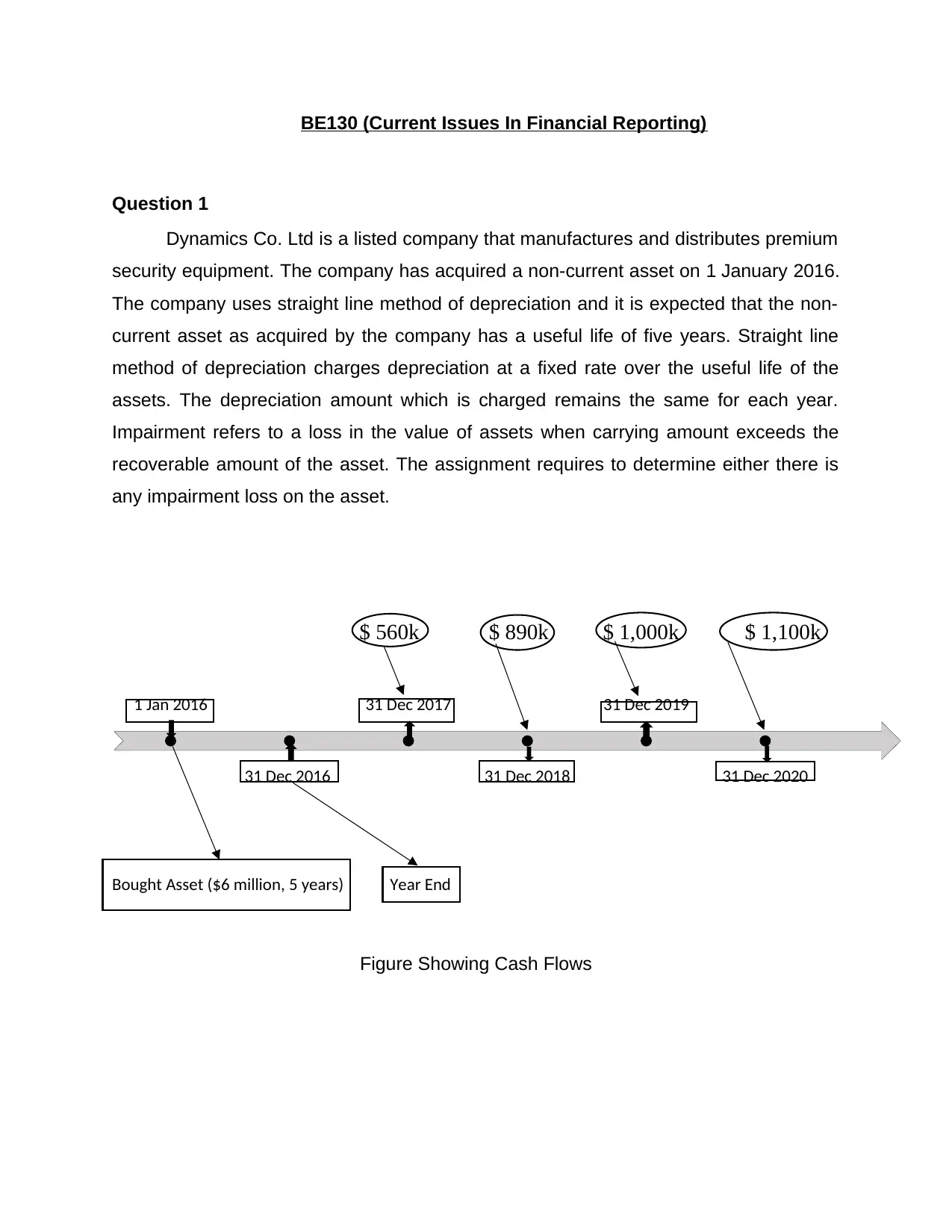
BE130 (Current Issues In Financial Reporting)
Question 1
Dynamics Co. Ltd is a listed company that manufactures and distributes premium
security equipment. The company has acquired a non-current asset on 1 January 2016.
The company uses straight line method of depreciation and it is expected that the non-
current asset as acquired by the company has a useful life of five years. Straight line
method of depreciation charges depreciation at a fixed rate over the useful life of the
assets. The depreciation amount which is charged remains the same for each year.
Impairment refers to a loss in the value of assets when carrying amount exceeds the
recoverable amount of the asset. The assignment requires to determine either there is
any impairment loss on the asset.
$ 560k $ 890k $ 1,000k $ 1,100k
Bought Asset ($6 million, 5 years) Year End
Figure Showing Cash Flows
1 Jan 2016
31 Dec 2016
31 Dec 2017
31 Dec 2018
31 Dec 2019
31 Dec 2020
Question 1
Dynamics Co. Ltd is a listed company that manufactures and distributes premium
security equipment. The company has acquired a non-current asset on 1 January 2016.
The company uses straight line method of depreciation and it is expected that the non-
current asset as acquired by the company has a useful life of five years. Straight line
method of depreciation charges depreciation at a fixed rate over the useful life of the
assets. The depreciation amount which is charged remains the same for each year.
Impairment refers to a loss in the value of assets when carrying amount exceeds the
recoverable amount of the asset. The assignment requires to determine either there is
any impairment loss on the asset.
$ 560k $ 890k $ 1,000k $ 1,100k
Bought Asset ($6 million, 5 years) Year End
Figure Showing Cash Flows
1 Jan 2016
31 Dec 2016
31 Dec 2017
31 Dec 2018
31 Dec 2019
31 Dec 2020
Paraphrase This Document
Need a fresh take? Get an instant paraphrase of this document with our AI Paraphraser
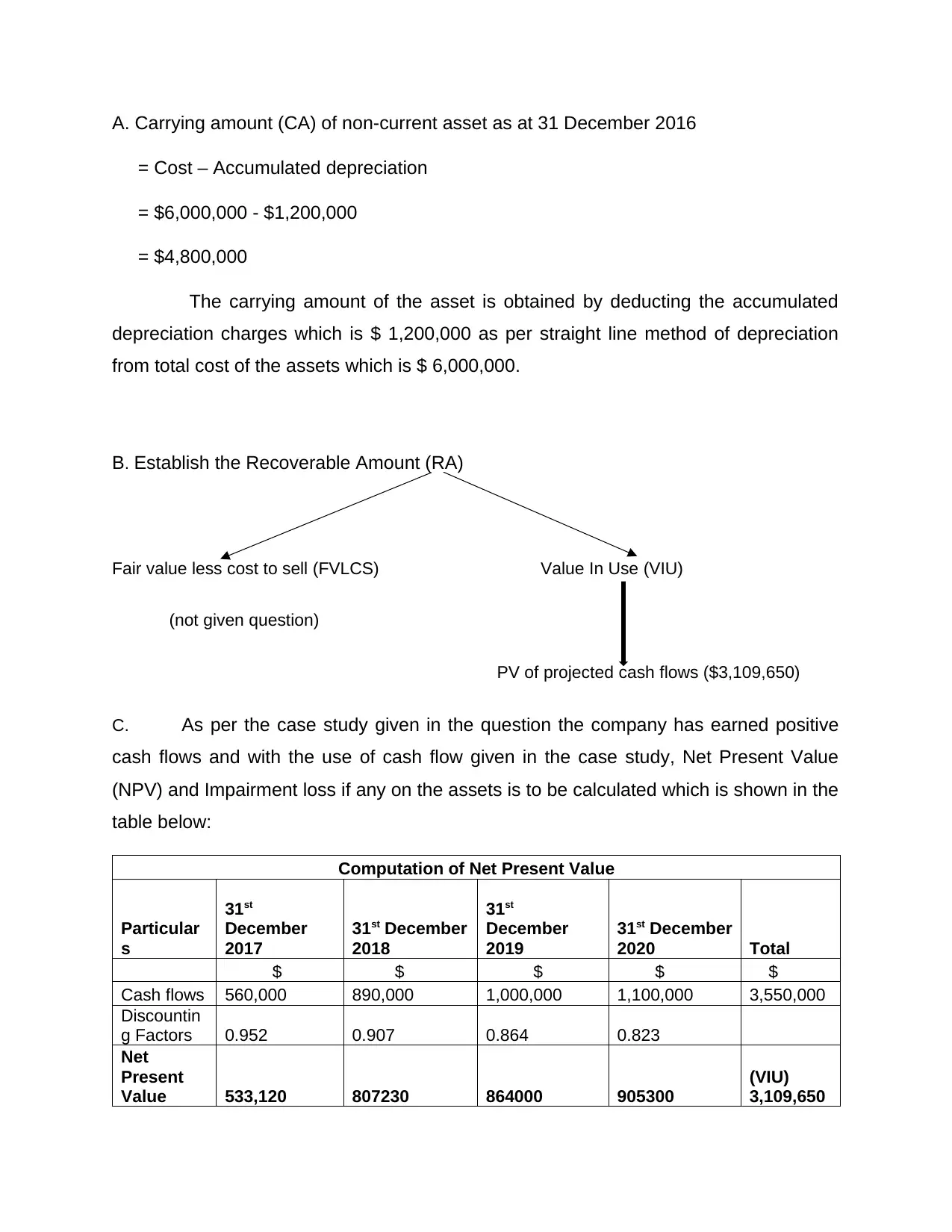
A. Carrying amount (CA) of non-current asset as at 31 December 2016
= Cost – Accumulated depreciation
= $6,000,000 - $1,200,000
= $4,800,000
The carrying amount of the asset is obtained by deducting the accumulated
depreciation charges which is $ 1,200,000 as per straight line method of depreciation
from total cost of the assets which is $ 6,000,000.
B. Establish the Recoverable Amount (RA)
Fair value less cost to sell (FVLCS) Value In Use (VIU)
(not given question)
PV of projected cash flows ($3,109,650)
C. As per the case study given in the question the company has earned positive
cash flows and with the use of cash flow given in the case study, Net Present Value
(NPV) and Impairment loss if any on the assets is to be calculated which is shown in the
table below:
Computation of Net Present Value
Particular
s
31st
December
2017
31st December
2018
31st
December
2019
31st December
2020 Total
$ $ $ $ $
Cash flows 560,000 890,000 1,000,000 1,100,000 3,550,000
Discountin
g Factors 0.952 0.907 0.864 0.823
Net
Present
Value 533,120 807230 864000 905300
(VIU)
3,109,650
= Cost – Accumulated depreciation
= $6,000,000 - $1,200,000
= $4,800,000
The carrying amount of the asset is obtained by deducting the accumulated
depreciation charges which is $ 1,200,000 as per straight line method of depreciation
from total cost of the assets which is $ 6,000,000.
B. Establish the Recoverable Amount (RA)
Fair value less cost to sell (FVLCS) Value In Use (VIU)
(not given question)
PV of projected cash flows ($3,109,650)
C. As per the case study given in the question the company has earned positive
cash flows and with the use of cash flow given in the case study, Net Present Value
(NPV) and Impairment loss if any on the assets is to be calculated which is shown in the
table below:
Computation of Net Present Value
Particular
s
31st
December
2017
31st December
2018
31st
December
2019
31st December
2020 Total
$ $ $ $ $
Cash flows 560,000 890,000 1,000,000 1,100,000 3,550,000
Discountin
g Factors 0.952 0.907 0.864 0.823
Net
Present
Value 533,120 807230 864000 905300
(VIU)
3,109,650
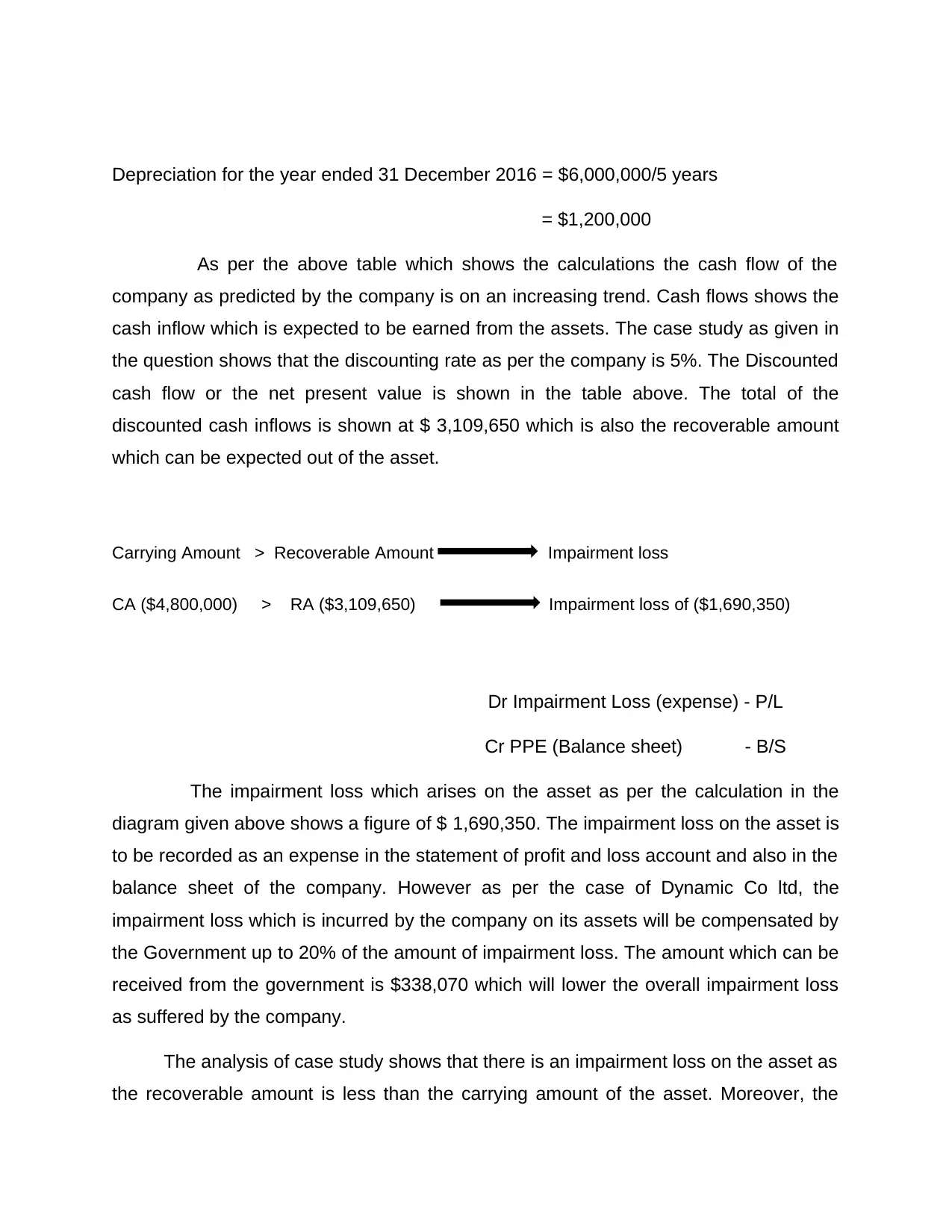
Depreciation for the year ended 31 December 2016 = $6,000,000/5 years
= $1,200,000
As per the above table which shows the calculations the cash flow of the
company as predicted by the company is on an increasing trend. Cash flows shows the
cash inflow which is expected to be earned from the assets. The case study as given in
the question shows that the discounting rate as per the company is 5%. The Discounted
cash flow or the net present value is shown in the table above. The total of the
discounted cash inflows is shown at $ 3,109,650 which is also the recoverable amount
which can be expected out of the asset.
Carrying Amount > Recoverable Amount Impairment loss
CA ($4,800,000) > RA ($3,109,650) Impairment loss of ($1,690,350)
Dr Impairment Loss (expense) - P/L
Cr PPE (Balance sheet) - B/S
The impairment loss which arises on the asset as per the calculation in the
diagram given above shows a figure of $ 1,690,350. The impairment loss on the asset is
to be recorded as an expense in the statement of profit and loss account and also in the
balance sheet of the company. However as per the case of Dynamic Co ltd, the
impairment loss which is incurred by the company on its assets will be compensated by
the Government up to 20% of the amount of impairment loss. The amount which can be
received from the government is $338,070 which will lower the overall impairment loss
as suffered by the company.
The analysis of case study shows that there is an impairment loss on the asset as
the recoverable amount is less than the carrying amount of the asset. Moreover, the
= $1,200,000
As per the above table which shows the calculations the cash flow of the
company as predicted by the company is on an increasing trend. Cash flows shows the
cash inflow which is expected to be earned from the assets. The case study as given in
the question shows that the discounting rate as per the company is 5%. The Discounted
cash flow or the net present value is shown in the table above. The total of the
discounted cash inflows is shown at $ 3,109,650 which is also the recoverable amount
which can be expected out of the asset.
Carrying Amount > Recoverable Amount Impairment loss
CA ($4,800,000) > RA ($3,109,650) Impairment loss of ($1,690,350)
Dr Impairment Loss (expense) - P/L
Cr PPE (Balance sheet) - B/S
The impairment loss which arises on the asset as per the calculation in the
diagram given above shows a figure of $ 1,690,350. The impairment loss on the asset is
to be recorded as an expense in the statement of profit and loss account and also in the
balance sheet of the company. However as per the case of Dynamic Co ltd, the
impairment loss which is incurred by the company on its assets will be compensated by
the Government up to 20% of the amount of impairment loss. The amount which can be
received from the government is $338,070 which will lower the overall impairment loss
as suffered by the company.
The analysis of case study shows that there is an impairment loss on the asset as
the recoverable amount is less than the carrying amount of the asset. Moreover, the
⊘ This is a preview!⊘
Do you want full access?
Subscribe today to unlock all pages.

Trusted by 1+ million students worldwide
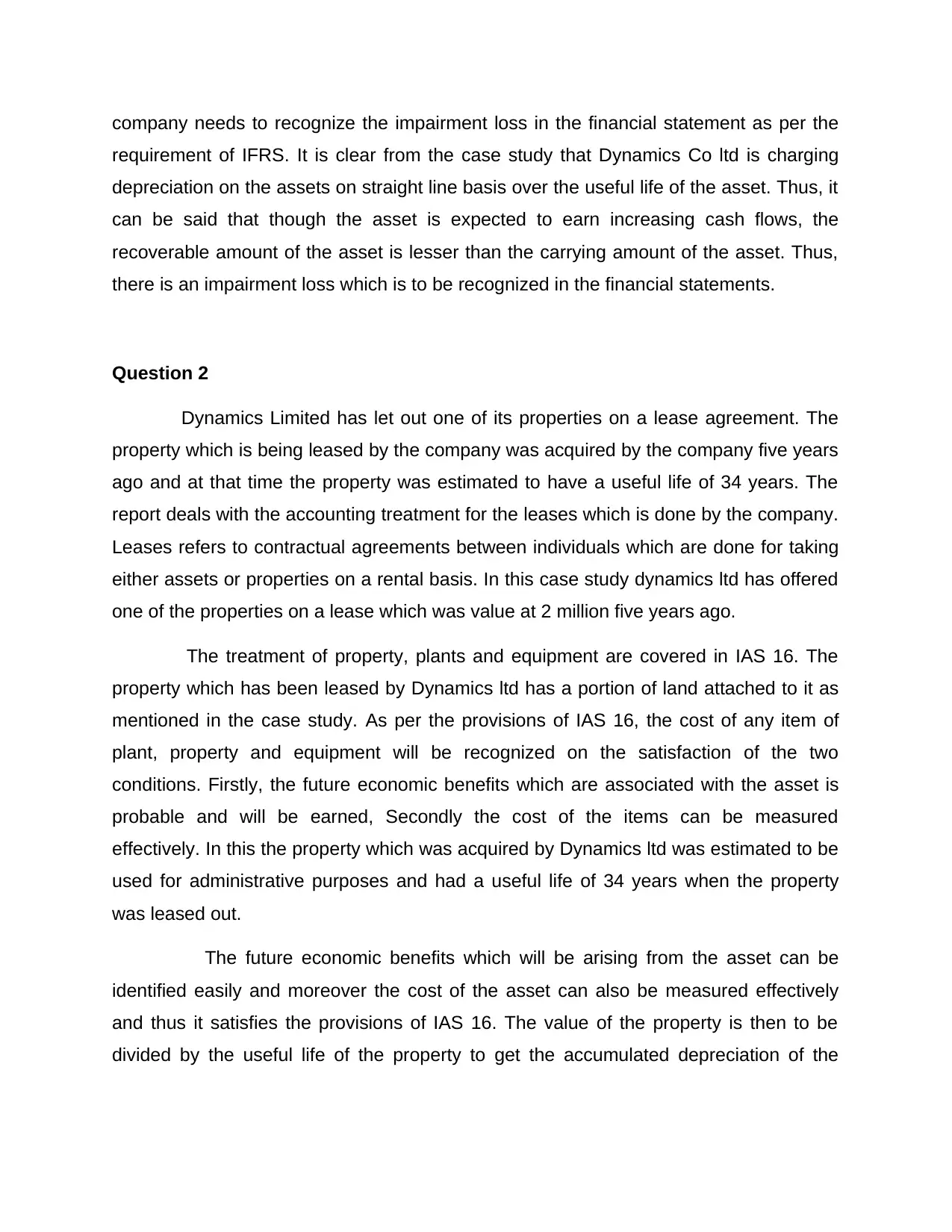
company needs to recognize the impairment loss in the financial statement as per the
requirement of IFRS. It is clear from the case study that Dynamics Co ltd is charging
depreciation on the assets on straight line basis over the useful life of the asset. Thus, it
can be said that though the asset is expected to earn increasing cash flows, the
recoverable amount of the asset is lesser than the carrying amount of the asset. Thus,
there is an impairment loss which is to be recognized in the financial statements.
Question 2
Dynamics Limited has let out one of its properties on a lease agreement. The
property which is being leased by the company was acquired by the company five years
ago and at that time the property was estimated to have a useful life of 34 years. The
report deals with the accounting treatment for the leases which is done by the company.
Leases refers to contractual agreements between individuals which are done for taking
either assets or properties on a rental basis. In this case study dynamics ltd has offered
one of the properties on a lease which was value at 2 million five years ago.
The treatment of property, plants and equipment are covered in IAS 16. The
property which has been leased by Dynamics ltd has a portion of land attached to it as
mentioned in the case study. As per the provisions of IAS 16, the cost of any item of
plant, property and equipment will be recognized on the satisfaction of the two
conditions. Firstly, the future economic benefits which are associated with the asset is
probable and will be earned, Secondly the cost of the items can be measured
effectively. In this the property which was acquired by Dynamics ltd was estimated to be
used for administrative purposes and had a useful life of 34 years when the property
was leased out.
The future economic benefits which will be arising from the asset can be
identified easily and moreover the cost of the asset can also be measured effectively
and thus it satisfies the provisions of IAS 16. The value of the property is then to be
divided by the useful life of the property to get the accumulated depreciation of the
requirement of IFRS. It is clear from the case study that Dynamics Co ltd is charging
depreciation on the assets on straight line basis over the useful life of the asset. Thus, it
can be said that though the asset is expected to earn increasing cash flows, the
recoverable amount of the asset is lesser than the carrying amount of the asset. Thus,
there is an impairment loss which is to be recognized in the financial statements.
Question 2
Dynamics Limited has let out one of its properties on a lease agreement. The
property which is being leased by the company was acquired by the company five years
ago and at that time the property was estimated to have a useful life of 34 years. The
report deals with the accounting treatment for the leases which is done by the company.
Leases refers to contractual agreements between individuals which are done for taking
either assets or properties on a rental basis. In this case study dynamics ltd has offered
one of the properties on a lease which was value at 2 million five years ago.
The treatment of property, plants and equipment are covered in IAS 16. The
property which has been leased by Dynamics ltd has a portion of land attached to it as
mentioned in the case study. As per the provisions of IAS 16, the cost of any item of
plant, property and equipment will be recognized on the satisfaction of the two
conditions. Firstly, the future economic benefits which are associated with the asset is
probable and will be earned, Secondly the cost of the items can be measured
effectively. In this the property which was acquired by Dynamics ltd was estimated to be
used for administrative purposes and had a useful life of 34 years when the property
was leased out.
The future economic benefits which will be arising from the asset can be
identified easily and moreover the cost of the asset can also be measured effectively
and thus it satisfies the provisions of IAS 16. The value of the property is then to be
divided by the useful life of the property to get the accumulated depreciation of the
Paraphrase This Document
Need a fresh take? Get an instant paraphrase of this document with our AI Paraphraser
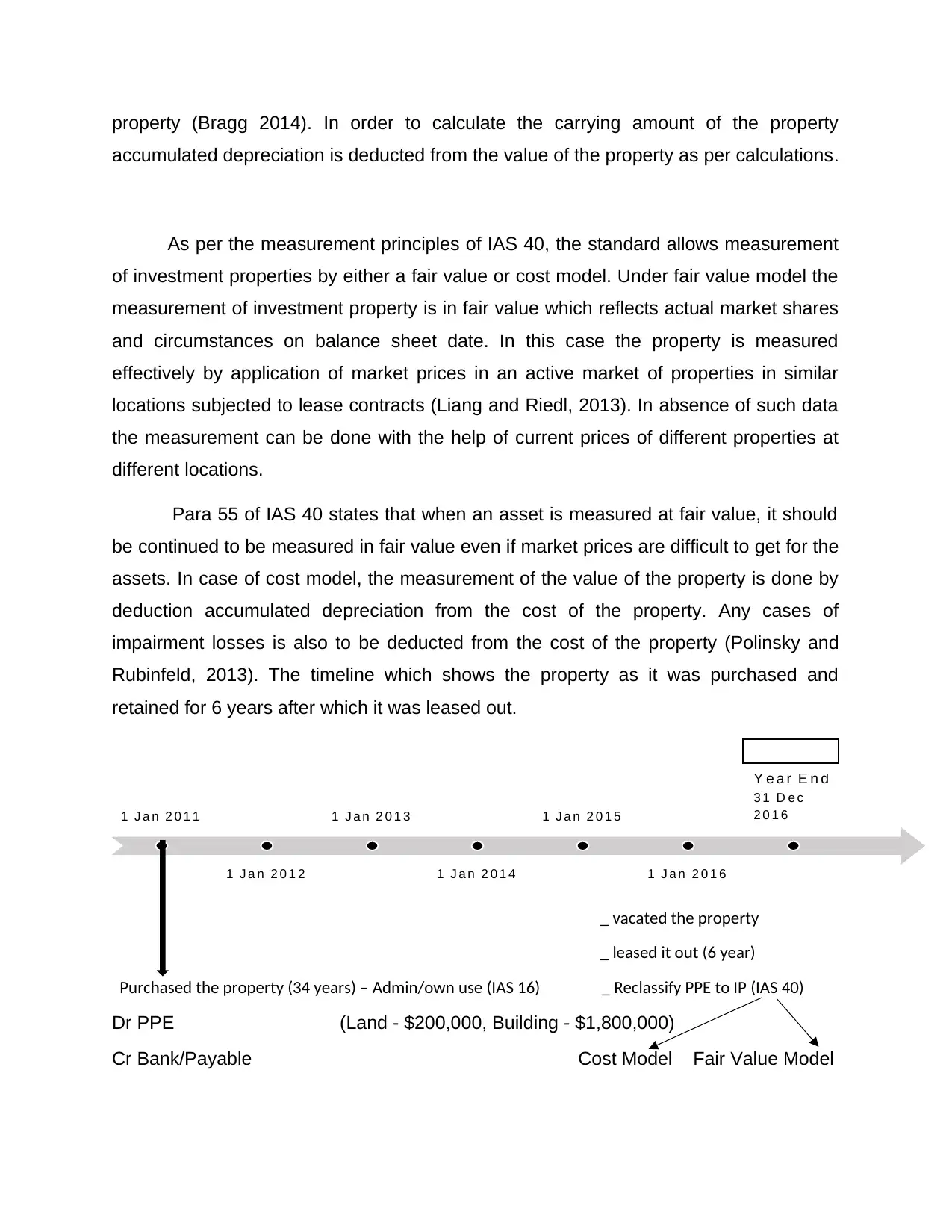
property (Bragg 2014). In order to calculate the carrying amount of the property
accumulated depreciation is deducted from the value of the property as per calculations.
As per the measurement principles of IAS 40, the standard allows measurement
of investment properties by either a fair value or cost model. Under fair value model the
measurement of investment property is in fair value which reflects actual market shares
and circumstances on balance sheet date. In this case the property is measured
effectively by application of market prices in an active market of properties in similar
locations subjected to lease contracts (Liang and Riedl, 2013). In absence of such data
the measurement can be done with the help of current prices of different properties at
different locations.
Para 55 of IAS 40 states that when an asset is measured at fair value, it should
be continued to be measured in fair value even if market prices are difficult to get for the
assets. In case of cost model, the measurement of the value of the property is done by
deduction accumulated depreciation from the cost of the property. Any cases of
impairment losses is also to be deducted from the cost of the property (Polinsky and
Rubinfeld, 2013). The timeline which shows the property as it was purchased and
retained for 6 years after which it was leased out.
_ vacated the property
_ leased it out (6 year)
Purchased the property (34 years) – Admin/own use (IAS 16) _ Reclassify PPE to IP (IAS 40)
Dr PPE (Land - $200,000, Building - $1,800,000)
Cr Bank/Payable Cost Model Fair Value Model
1 J a n 2 0 1 1
1 J a n 2 0 1 2
1 J a n 2 0 1 3
1 J a n 2 0 1 4
1 J a n 2 0 1 5
1 J a n 2 0 1 6
Y e a r E n d
3 1 D e c
2 0 1 6
accumulated depreciation is deducted from the value of the property as per calculations.
As per the measurement principles of IAS 40, the standard allows measurement
of investment properties by either a fair value or cost model. Under fair value model the
measurement of investment property is in fair value which reflects actual market shares
and circumstances on balance sheet date. In this case the property is measured
effectively by application of market prices in an active market of properties in similar
locations subjected to lease contracts (Liang and Riedl, 2013). In absence of such data
the measurement can be done with the help of current prices of different properties at
different locations.
Para 55 of IAS 40 states that when an asset is measured at fair value, it should
be continued to be measured in fair value even if market prices are difficult to get for the
assets. In case of cost model, the measurement of the value of the property is done by
deduction accumulated depreciation from the cost of the property. Any cases of
impairment losses is also to be deducted from the cost of the property (Polinsky and
Rubinfeld, 2013). The timeline which shows the property as it was purchased and
retained for 6 years after which it was leased out.
_ vacated the property
_ leased it out (6 year)
Purchased the property (34 years) – Admin/own use (IAS 16) _ Reclassify PPE to IP (IAS 40)
Dr PPE (Land - $200,000, Building - $1,800,000)
Cr Bank/Payable Cost Model Fair Value Model
1 J a n 2 0 1 1
1 J a n 2 0 1 2
1 J a n 2 0 1 3
1 J a n 2 0 1 4
1 J a n 2 0 1 5
1 J a n 2 0 1 6
Y e a r E n d
3 1 D e c
2 0 1 6
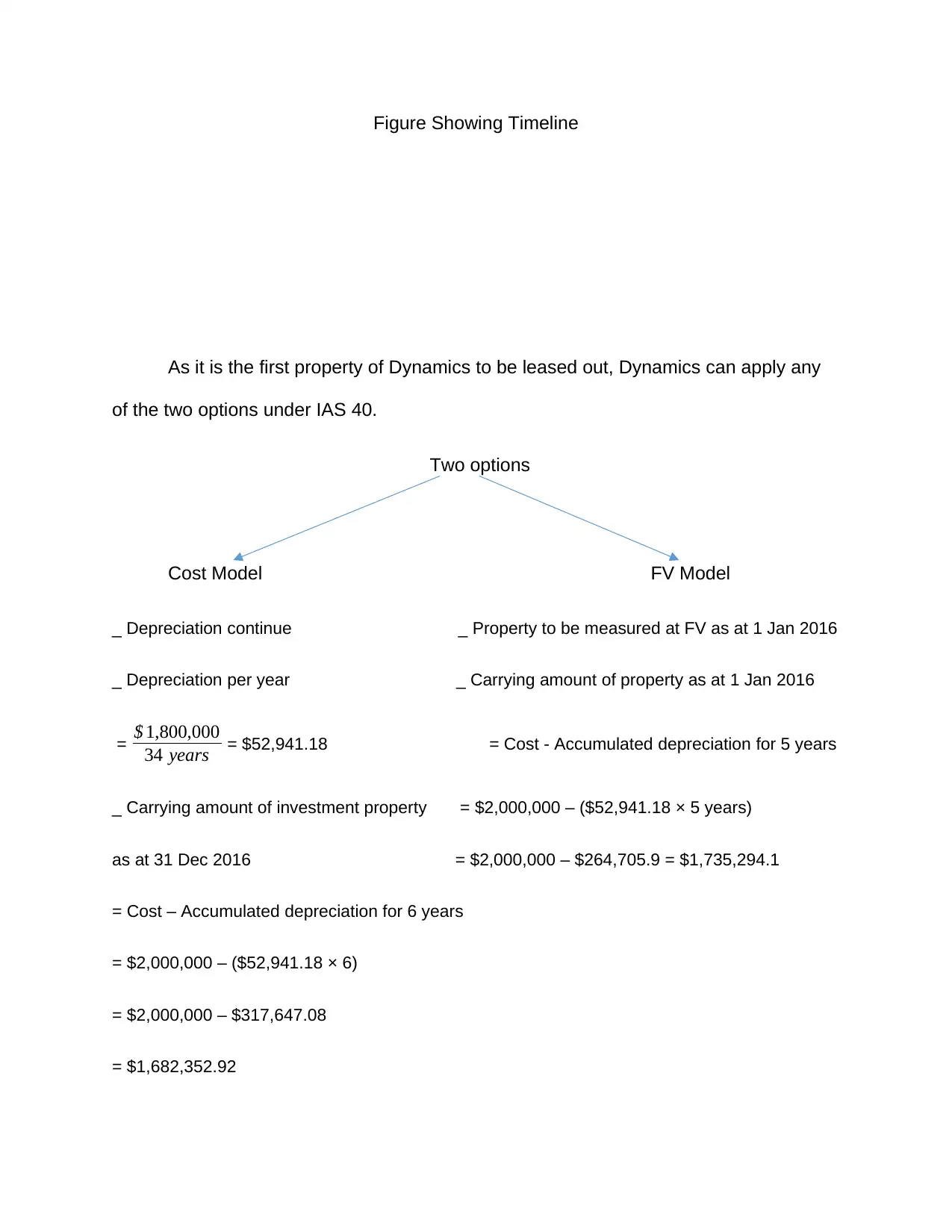
Figure Showing Timeline
As it is the first property of Dynamics to be leased out, Dynamics can apply any
of the two options under IAS 40.
Two options
Cost Model FV Model
_ Depreciation continue _ Property to be measured at FV as at 1 Jan 2016
_ Depreciation per year _ Carrying amount of property as at 1 Jan 2016
= $ 1,800,000
34 years = $52,941.18 = Cost - Accumulated depreciation for 5 years
_ Carrying amount of investment property = $2,000,000 – ($52,941.18 × 5 years)
as at 31 Dec 2016 = $2,000,000 – $264,705.9 = $1,735,294.1
= Cost – Accumulated depreciation for 6 years
= $2,000,000 – ($52,941.18 × 6)
= $2,000,000 – $317,647.08
= $1,682,352.92
As it is the first property of Dynamics to be leased out, Dynamics can apply any
of the two options under IAS 40.
Two options
Cost Model FV Model
_ Depreciation continue _ Property to be measured at FV as at 1 Jan 2016
_ Depreciation per year _ Carrying amount of property as at 1 Jan 2016
= $ 1,800,000
34 years = $52,941.18 = Cost - Accumulated depreciation for 5 years
_ Carrying amount of investment property = $2,000,000 – ($52,941.18 × 5 years)
as at 31 Dec 2016 = $2,000,000 – $264,705.9 = $1,735,294.1
= Cost – Accumulated depreciation for 6 years
= $2,000,000 – ($52,941.18 × 6)
= $2,000,000 – $317,647.08
= $1,682,352.92
⊘ This is a preview!⊘
Do you want full access?
Subscribe today to unlock all pages.

Trusted by 1+ million students worldwide
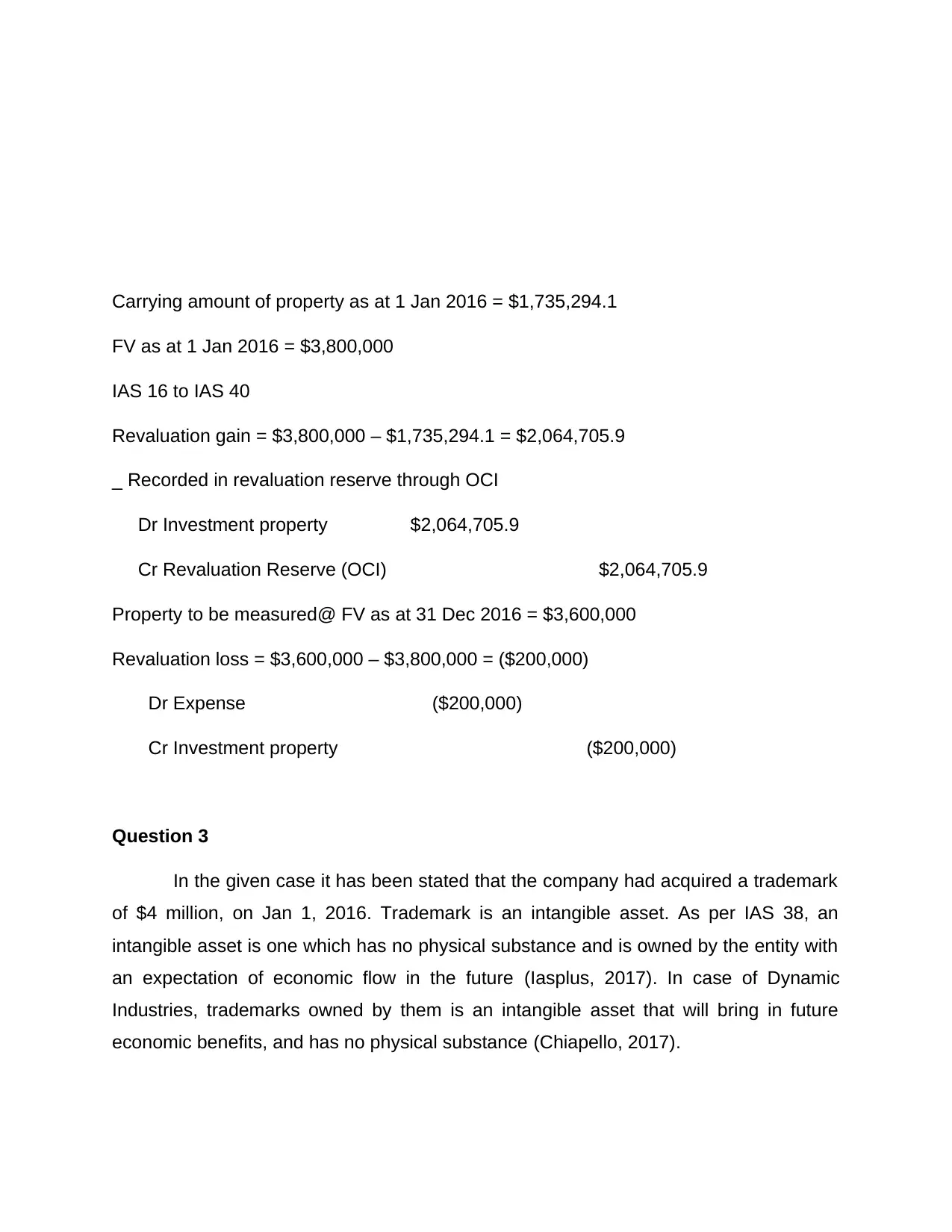
Carrying amount of property as at 1 Jan 2016 = $1,735,294.1
FV as at 1 Jan 2016 = $3,800,000
IAS 16 to IAS 40
Revaluation gain = $3,800,000 – $1,735,294.1 = $2,064,705.9
_ Recorded in revaluation reserve through OCI
Dr Investment property $2,064,705.9
Cr Revaluation Reserve (OCI) $2,064,705.9
Property to be measured@ FV as at 31 Dec 2016 = $3,600,000
Revaluation loss = $3,600,000 – $3,800,000 = ($200,000)
Dr Expense ($200,000)
Cr Investment property ($200,000)
Question 3
In the given case it has been stated that the company had acquired a trademark
of $4 million, on Jan 1, 2016. Trademark is an intangible asset. As per IAS 38, an
intangible asset is one which has no physical substance and is owned by the entity with
an expectation of economic flow in the future (Iasplus, 2017). In case of Dynamic
Industries, trademarks owned by them is an intangible asset that will bring in future
economic benefits, and has no physical substance (Chiapello, 2017).
FV as at 1 Jan 2016 = $3,800,000
IAS 16 to IAS 40
Revaluation gain = $3,800,000 – $1,735,294.1 = $2,064,705.9
_ Recorded in revaluation reserve through OCI
Dr Investment property $2,064,705.9
Cr Revaluation Reserve (OCI) $2,064,705.9
Property to be measured@ FV as at 31 Dec 2016 = $3,600,000
Revaluation loss = $3,600,000 – $3,800,000 = ($200,000)
Dr Expense ($200,000)
Cr Investment property ($200,000)
Question 3
In the given case it has been stated that the company had acquired a trademark
of $4 million, on Jan 1, 2016. Trademark is an intangible asset. As per IAS 38, an
intangible asset is one which has no physical substance and is owned by the entity with
an expectation of economic flow in the future (Iasplus, 2017). In case of Dynamic
Industries, trademarks owned by them is an intangible asset that will bring in future
economic benefits, and has no physical substance (Chiapello, 2017).
Paraphrase This Document
Need a fresh take? Get an instant paraphrase of this document with our AI Paraphraser
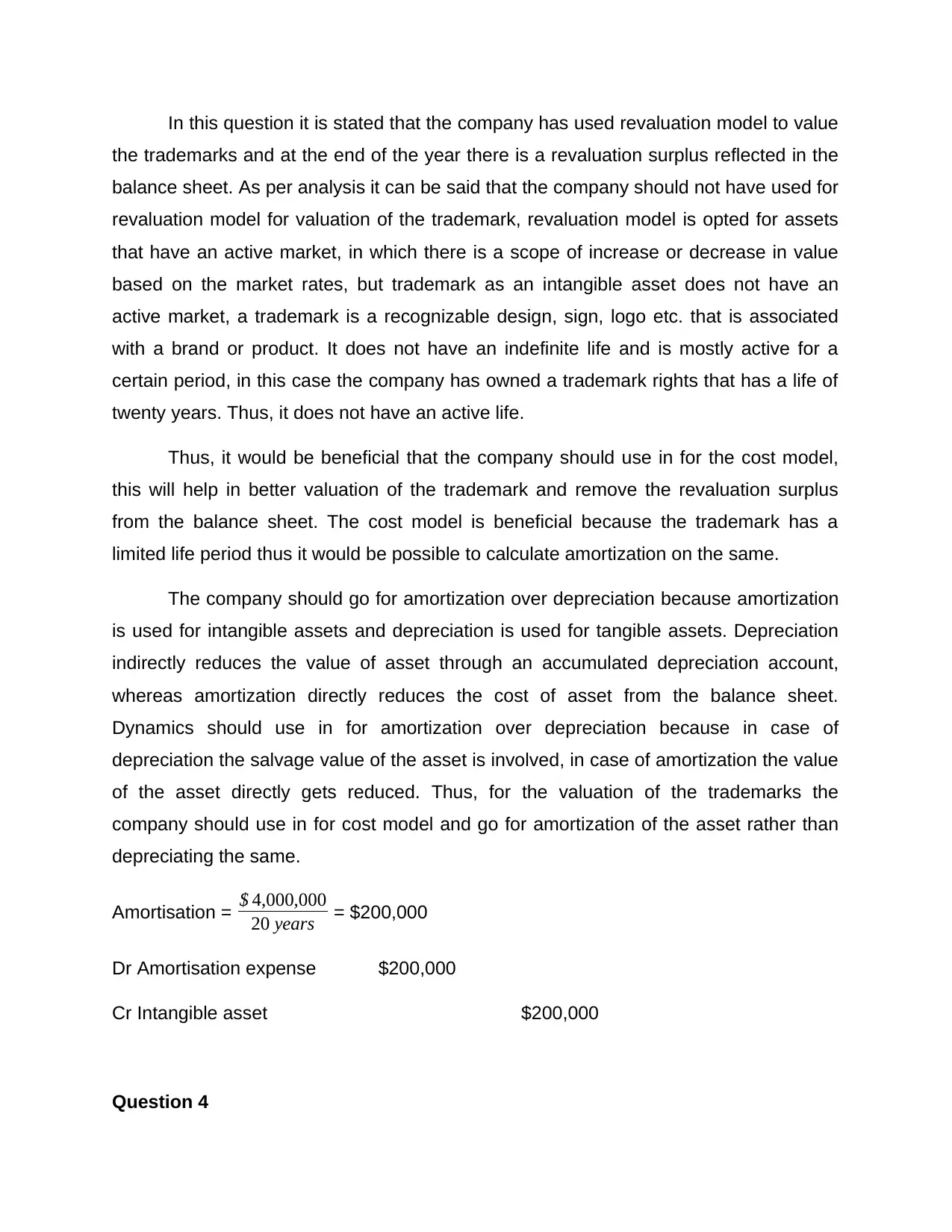
In this question it is stated that the company has used revaluation model to value
the trademarks and at the end of the year there is a revaluation surplus reflected in the
balance sheet. As per analysis it can be said that the company should not have used for
revaluation model for valuation of the trademark, revaluation model is opted for assets
that have an active market, in which there is a scope of increase or decrease in value
based on the market rates, but trademark as an intangible asset does not have an
active market, a trademark is a recognizable design, sign, logo etc. that is associated
with a brand or product. It does not have an indefinite life and is mostly active for a
certain period, in this case the company has owned a trademark rights that has a life of
twenty years. Thus, it does not have an active life.
Thus, it would be beneficial that the company should use in for the cost model,
this will help in better valuation of the trademark and remove the revaluation surplus
from the balance sheet. The cost model is beneficial because the trademark has a
limited life period thus it would be possible to calculate amortization on the same.
The company should go for amortization over depreciation because amortization
is used for intangible assets and depreciation is used for tangible assets. Depreciation
indirectly reduces the value of asset through an accumulated depreciation account,
whereas amortization directly reduces the cost of asset from the balance sheet.
Dynamics should use in for amortization over depreciation because in case of
depreciation the salvage value of the asset is involved, in case of amortization the value
of the asset directly gets reduced. Thus, for the valuation of the trademarks the
company should use in for cost model and go for amortization of the asset rather than
depreciating the same.
Amortisation = $ 4,000,000
20 years = $200,000
Dr Amortisation expense $200,000
Cr Intangible asset $200,000
Question 4
the trademarks and at the end of the year there is a revaluation surplus reflected in the
balance sheet. As per analysis it can be said that the company should not have used for
revaluation model for valuation of the trademark, revaluation model is opted for assets
that have an active market, in which there is a scope of increase or decrease in value
based on the market rates, but trademark as an intangible asset does not have an
active market, a trademark is a recognizable design, sign, logo etc. that is associated
with a brand or product. It does not have an indefinite life and is mostly active for a
certain period, in this case the company has owned a trademark rights that has a life of
twenty years. Thus, it does not have an active life.
Thus, it would be beneficial that the company should use in for the cost model,
this will help in better valuation of the trademark and remove the revaluation surplus
from the balance sheet. The cost model is beneficial because the trademark has a
limited life period thus it would be possible to calculate amortization on the same.
The company should go for amortization over depreciation because amortization
is used for intangible assets and depreciation is used for tangible assets. Depreciation
indirectly reduces the value of asset through an accumulated depreciation account,
whereas amortization directly reduces the cost of asset from the balance sheet.
Dynamics should use in for amortization over depreciation because in case of
depreciation the salvage value of the asset is involved, in case of amortization the value
of the asset directly gets reduced. Thus, for the valuation of the trademarks the
company should use in for cost model and go for amortization of the asset rather than
depreciating the same.
Amortisation = $ 4,000,000
20 years = $200,000
Dr Amortisation expense $200,000
Cr Intangible asset $200,000
Question 4

⊘ This is a preview!⊘
Do you want full access?
Subscribe today to unlock all pages.

Trusted by 1+ million students worldwide
1 out of 9
Related Documents
Your All-in-One AI-Powered Toolkit for Academic Success.
+13062052269
info@desklib.com
Available 24*7 on WhatsApp / Email
![[object Object]](/_next/static/media/star-bottom.7253800d.svg)
Unlock your academic potential
Copyright © 2020–2025 A2Z Services. All Rights Reserved. Developed and managed by ZUCOL.





